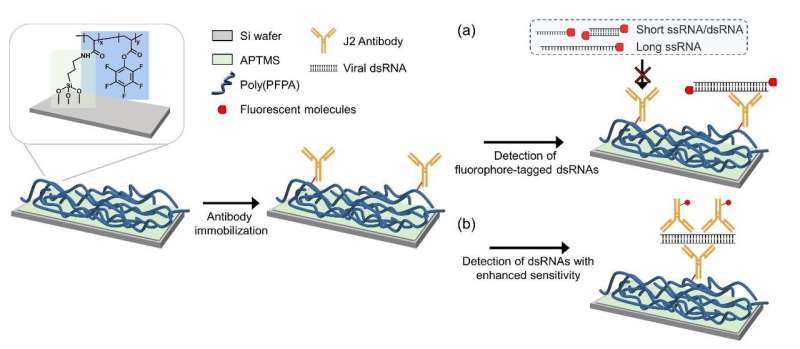Schematics of the reactive polymer-coated surface for dsRNA capture and detection. Credit: KAIST
The quick, accurate detection of a virus on a wide scale is the key to combating infectious diseases such as COVID-19. A new viral diagnostic strategy using reactive polymer-grafted, double-stranded RNAs will serve as a pre-screening tester for a wide range of viruses with enhanced sensitivity.
Currently, the most widely used viral detection methodology is polymerase chain reaction (PCR) diagnosis, which amplifies and detects a piece of the viral genome. Prior knowledge of the relevant primer nucleic acids of the virus is essential for this test.
The detection platform developed by KAIST researchers identifies viral activities without amplifying specific nucleic acid targets. The research team, co-led by Professor Sheng Li and Professor Yoosik Kim from the Department of Chemical and Biomolecular Engineering, constructed a universal virus detection platform by using the distinct features of the PPFPA-grafted surface and double-stranded RNAs.
The key principle of this platform is using reactive polymer-grafted surfaces, which serve as a versatile platform for the immobilization of functional molecules. These activated surfaces can be used in a wide range of applications including separation, delivery and detection. As long, double-stranded RNAs are common byproducts of viral transcription and replication, these PPFPA-grafted surfaces can detect the presence of different kinds of viruses without prior knowledge of their genomic sequences.
"We employed the PPFPA-grafted silicon surface to develop a universal virus detection platform by immobilizing antibodies that recognize double-stranded RNAs," said Professor Kim.
To increase detection sensitivity, the research team devised two-step detection process analogs to sandwich an enzyme-linked immunosorbent assay where the bound double-stranded RNAs are then visualized using fluorophore-tagged antibodies that also recognize the double-stranded secondary structure of the RNAs.
The platform can detect long, double-stranded RNAs and visualize from an RNA mixture, as well as from total cell lysates, which contain a mixture of abundant contaminants such as DNAs and proteins. The research team successfully detected elevated levels of hepatitis C and A viruses with this tool.
"This new technology allows us to take on virus detection from a new perspective. By targeting a common biomarker, viral double-stranded RNAs, we can develop a pre-screening platform that can quickly differentiate infected populations from non-infected ones," said Professor Li.
"This detection platform provides new perspectives for diagnosing infectious diseases. This will provide fast and accurate diagnoses for an infected population and prevent the influx of massive outbreaks," said Professor Kim.
More information: Jayoung Ku et al, Reactive Polymer Targeting dsRNA as Universal Virus Detection Platform with Enhanced Sensitivity, Biomacromolecules (2020). DOI: 10.1021/acs.biomac.0c00379
Journal information: Biomacromolecules
























